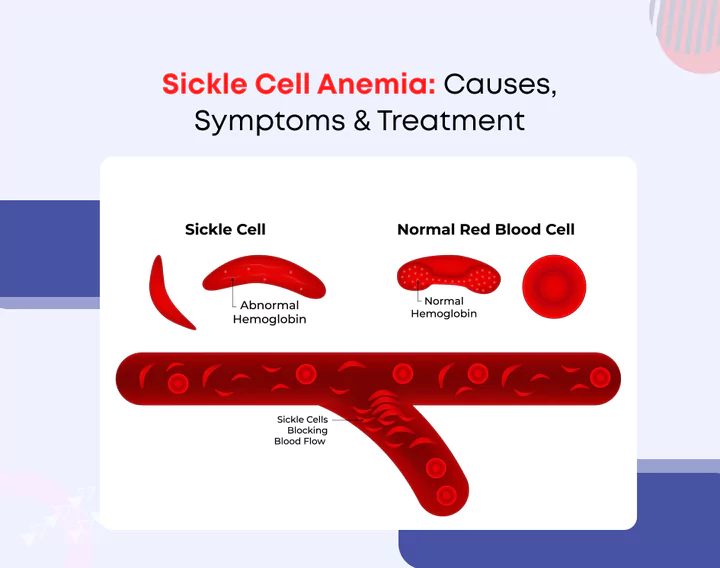
Sickle Cell Anemia: Causes, Symptoms & Treatment
Sickle cell anemia is one of the genetic diseases which is known to affect millions of people worldwide. The disease is rare and usually genetic, and the red blood cells they contain are rigid and often have a crescent instead of being round as normal. The crescent cells cause blockage of blood circulation, hence leading to pain, infections, and organ damage. Therefore, it remains vital that sufferers themselves and those close to them – including friends and carers – are aware of sickle cell anemia.
This blog will, therefore, cover details on the causes, symptoms and treatment of sickle cell anemia so as to make it easier for sufferers of this disease to know better how to handle it and enhance their quality of life.
What Causes Sickle Cell Anemia?
Sickle cell anemia is a genetic disorder passed down from parents to their children. It occurs when the abnormal sickle-shaped cells are present in the blood.
Genetic Inheritance
Sickle cell anemia is primarily caused by a genetic mutation in the gene responsible for haemoglobin production.
Inherited Trait: When both parents have HbAS, there is a 25% syndrome of passing of this disease to their child, which is also known as sickle cell anemia (HbSS).
Carriers: Those who are referred to as having sickle cell genes have one gene that carries the disease and the other normal gene; therefore, they are said to have sickle cell traits but are usually asymptomatic.
Symptoms of Sickle Cell Anemia
Painful Attacks (Crisis)
One of the most common symptoms of sickle cell anemia is a painful crisis:
Triggers: Some of the factors that trigger these painful episodes include dehydration, stress, infections or extreme temperatures.
Vaso-occlusive Crisis: When sickle-shaped cells impede blood flow to certain areas of the body, this type of crisis can occur, resulting in severe pains that may last from hours to days, sometimes making hospitalisation necessary.
Management of these crises is vital in improving the quality of life for those with sickle cell anemia.
Anemia
Sickle cell anemia can lead to chronic anemia, which is a lack of normal red blood cells:
Fatigue: Anemia may cause extended feelings of tiredness and weakness because oxygen-carrying abilities have been reduced.
Paleness and Jaundice: In addition, anemia symptoms usually include pale skin and yellowish colour change in eyes as well as skin (jaundice).
Regular monitoring and treatment of anemia are essential in preventing complications.
Frequent Infections
Patients suffering from sickle cell anemia are at a higher risk of getting infected.
Common Infections: Sickle cell anemic individuals are more likely to have pneumonia, meningitis and other bacterial infections.
Splenic Dysfunction: Sickle-shaped cells can damage the spleen – which supports immunity – thus opening up the door towards increased infection incidences.
In order to manage this condition effectively, it is important to prevent infections through vaccinations and regular medical reviews.
Delayed Growth and Development
The growth rate and puberty period might take longer time in children who have SCA.
Puberty Delays: Ongoing body strain can delay puberty in adolescents.
Growth Issues: Chronic anemia leads to stunted growth, resulting in shorter heights than those of their peers.
The close supervision of development/growth can aid these effects by facilitating timely intervention whenever required.
Vision Problems
Additionally, sickle cell anemia can impair vision too.
Regular Eye Exams: For early detection of any visual complications, periodic eye examinations should be done.
Retinal Damage: Retinal damage occurs because of the occlusion present within ocular vasculature, leading to either decreased sight or total loss without treatment.
Eye health protection is a major aspect of sickle cell anemia management.
Complications of Sickle Cell Anemia
Sickle cell anemia can lead to various complications that pose significant threats to overall health. Being aware of these complications can facilitate early intervention and management.
Acute Chest Syndrome
A severe complication of sickle cell anemia is acute chest syndrome.
Symptoms: It is related to pneumonia and has symptoms like chest pains, high fever and problems in breathing.
Causes: This issue can be caused by infected blood vessels in the lungs or obstructed vessels and lead to rather dangerous conditions.
Indeed, it is critical to note that for one to treat SCA-CS, one should seek medical help right away.
Stroke
There is an increased risk of stroke as a result of sickle cell anemia.
Blood Flow Blockages: This is the case when a sickle-shaped cell causes a hindrance in blood flow to the brain, and a stroke will occur.
Symptoms: These are normally accompanied by features such as sudden weakness, problems in speech, or tingling sensations in any part of the body.
In individuals with sickle cell anemia, measures that can be taken and health checks to be carried out could contribute to the prophylactic effects of strokes in such persons.
Organ Damage
The persistent stopping of blood flow can harm various organs.
Kidneys, Liver, Heart: Such organs are most vulnerable to complications occasioned by sickle cell disease.
Causes: It can be caused by infected blood vessels in the lungs or obstructed vessels and lead to rather dangerous conditions.
Organ Failure: As a result of the damage, any organ can fail, and the patient continues to need care and possibly more invasive treatments such as dialysis or transplants. It is also very important to monitor the function of organs more often to avoid the most serious outcomes.
Diagnosing Sickle Cell Anemia
The situation can be managed well if sickle cell anemia is diagnosed early enough.
Newborn Screening
Most nations test for sickle cell anemia at birth.
Blood Test: Detecting of sickle haemoglobin in a person can be done using a simple blood test.
Early Intervention: As soon as this disorder is recognised, it has to be treated properly, and further complications are reduced to a minimum.
Genetic Testing
Sickle cell anemia can be diagnosed genetically.
Carrier Status: For instance, some persons possess genes that have elements of sickles in them.
Family History: When a person was definitely born of ancestors who had sickle cell anemia, such a person might wish to seek genetic advice and testing as to the potential of the next generation in that family contracting the disease.
Understanding genetic predispositions is the basis of sickle cell anemia management as well as preventing it in successive generations.
Treatment Options for Sickle Cell Anemia
To date, there is no cure for sickle cell anemia, but the symptoms can be well controlled by a number of techniques.
Medications
Medications help to ease the effects of sickle cell anemia.
Pain Relief: Medications to relieve pain should be accessible in painful attacks.
Antibiotics: Antibiotics are taken regularly, particularly amongst children, to prevent infections from occurring.
Hydroxyurea: It might also decrease the pain episode occurrence rates and the need for blood transfusions.
The striking aspect of managing the symptoms of sickle cell anemia, therefore, entails substantial interdependence with the healthcare providers.
Blood Transfusions
Blood transfusion is a widely used treatment for managing patients with sickle cell anemia.
Preventing Complications: Such a transfusion will negate instances like a stroke in patients operating at high-risk levels.
Boosting Red Blood Cells: The process augments the quantity of healthy red blood cells so as to enhance the delivery of oxygen to tissues.
However, during this therapy, there are some drawbacks that should be controlled; for example, iron toxicity due to the accumulation of iron from repeated transfusions.
Bone Marrow Transplant
There is no alternative to bone marrow transplant for sickle cell anemia as it remains the only possible remedy.
Risks: This type of operation carries significant risk and is typically performed only in exceptional cases; it may ultimately eliminate these cells.
Displacing Damaged Cells: It involves the exchange of the one containing the donor’s normal marrow for the one with abnormal red blood cells in sick patients.
It is, for this reason, necessary for the people who would like to opt for this option to consult with the a hematologist about the benefits and consequences that are connected with it.
Preventing Complications in Sickle Cell Anemia
Preventing complications is a key aspect of managing sickle cell anemia.
Regular Medical Check-Ups
Regular check-ups are essential for monitoring health and preventing complications:
Monitoring Growth: A child who is expected to show growth and development experiences a checkup to fix any developmental issues.
Vaccinations: Prompt vaccination can help prevent serious infections since it is the key way of ensuring that the immunity systems of the body are running optimally.
Outpatient follow-up is also required for patients diagnosed with sickle cell anemia, as there are many complications arising from the disease.
Healthy Lifestyle Choices
Maintaining a healthy lifestyle can help manage sickle cell anemia.
Balanced Diet: Prioritizing healthy foods boosts mineral and vitamin intake, improving overall health.
Stress Management: Managing stress is also important in order to avoid the flare-up of painful crises as much as possible.
Hydration: Finally, there are ways people with the disease can manage it: they need to be well-hydrated to avoid sickle cell crises.
The common knowledge that enables an individual to adopt correct measures can make a huge difference in the quality of life of sickle cell anemia patients.
Finishing Up
Sickle cell anemia is not an easy disease, but with proper intervention measures, people who are affected can live full lives. Essential knowledge about this hereditary disease includes the primary signs and symptoms and effective therapeutic approaches. Thus, to avoid complications arising from the disease, people with SCA should observe and seek medical check-ups, personal hygiene, healthy diet and other optimal practices.
Sickle cell anemia can only be managed if diagnosed early and treated in a timely manner so that the quality of life of the affected persons is improved. For anyone who lives or knows someone with sickle cell anemia, please do not shy away from seeking medical advice.






